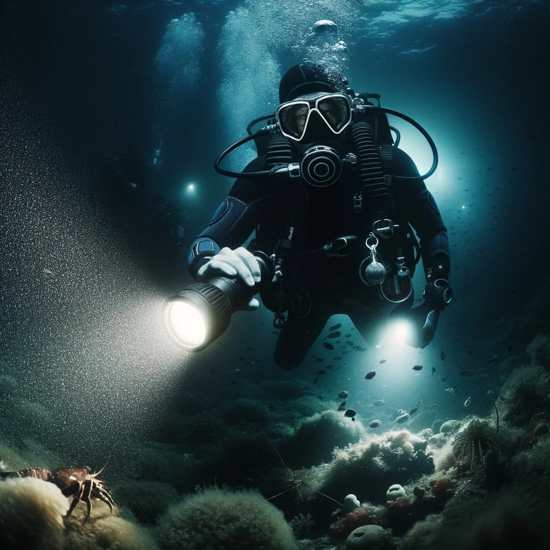
Imagine descending into the inky depths of the ocean as the sun sets, armed with nothing but your dive light and a sense of adventure. The underwater world transforms into a completely different realm at night, teeming with nocturnal creatures and glowing with bioluminescent wonders. Night diving offers a unique and thrilling experience for scuba enthusiasts, revealing a hidden side of the marine environment that remains unseen during the day.
In this guide, we'll explore why night diving should be on every diver's bucket list, the essential gear you'll need, and the tips and safety considerations to ensure a successful and memorable dive. Whether you're a seasoned diver looking for a new challenge or a beginner curious about the mysteries of the deep after dark, this ultimate guide to night diving has got you covered. Dive in with us and discover the magic that awaits beneath the waves at night.
Why Try Night Diving?
Night diving is a thrilling adventure that offers a completely different perspective on the underwater world. Here are some compelling reasons to give it a try:
The Thrill of Exploring a Different Underwater World
The ocean at night is a mysterious and enchanting place. The limited visibility and the focus of your dive light create a tunnel vision effect, making every sight and encounter feel more intense and immediate. The experience of navigating through the dark waters adds an element of excitement and novelty to your dives.
Encountering Nocturnal Marine Creatures
Many marine animals are nocturnal, meaning they are active at night when the majority of divers are not around. On a night dive, you might see creatures that you rarely, if ever, encounter during daytime dives. From octopuses and lobsters to certain species of fish and eels, the night shift of marine life comes out to hunt and explore.
Experiencing Bioluminescence
One of the most magical aspects of night diving is witnessing bioluminescence. Some marine organisms, such as plankton, emit light when disturbed. As you move through the water, you may find yourself surrounded by a sparkling display of tiny, glowing lights. It's an otherworldly experience that is often compared to swimming among the stars.
Essential Gear for Night Diving
To ensure a safe and enjoyable night dive, you’ll need some specialized equipment:
Dive Lights
A reliable primary dive light is essential for illuminating your surroundings and signaling your buddy. Additionally, it's wise to carry a backup light in case your primary light fails. LED lights are popular for their brightness and battery efficiency.
Light Sticks or Markers
Attach light sticks or markers to your tank, BCD, and other equipment to make yourself and your gear more visible. This also helps your dive buddy keep track of you in the dark.
Exposure Protection
Nighttime temperatures can be cooler, both in the air and underwater. Ensure you have appropriate exposure protection, such as a wetsuit or drysuit, to stay warm and comfortable throughout the dive.
Tips for a Successful Night Dive
Here are some tips to help you make the most of your night diving experience:
Plan Your Dive
Thorough planning is crucial for night dives. Familiarize yourself with the dive site during the day, noting key landmarks and potential hazards. Ensure you have a clear dive plan, including depth, time, and navigation details.
Stay Close to Your Buddy
Communication and visibility are more challenging at night, so it’s essential to stay close to your dive buddy. Establish a system of light signals and maintain constant visual contact.
Use Proper Lighting Techniques
Master the use of your dive lights to enhance your visibility and communication. Avoid shining your light directly into your buddy’s eyes, and use it to point out interesting sights or signal your location.
Stay Calm and Move Slowly
The dark, unfamiliar environment can be disorienting, so it’s important to stay calm and move slowly. This not only helps you conserve air but also prevents startling marine life and stirring up sediment, which can reduce visibility.
Safety Considerations
Safety is paramount when night diving. Keep these considerations in mind:
Thorough Dive Briefings
A comprehensive dive briefing is essential before any night dive. Ensure everyone is aware of the dive plan, signals, and emergency procedures.
Clear Communication Signals
Establish clear communication signals using your dive lights and hand signals. Practice these signals with your buddy before descending.
Regular Equipment Checks
Perform thorough checks of your equipment, including lights and backup lights, before the dive. Ensure all gear is in good working order and properly secured.
Experiencing Bioluminescence
Bioluminescence is one of the most captivating aspects of night diving. Here’s how to make the most of it:
What is Bioluminescence?
Bioluminescence is the production and emission of light by living organisms. In the ocean, many types of plankton, jellyfish, and other marine creatures can produce bioluminescent displays.
How to Spot Bioluminescent Organisms
To see bioluminescence, turn off your dive light and move your hand or fin through the water. The disturbance often triggers a glow from the bioluminescent organisms. Be patient and give your eyes time to adjust to the darkness.